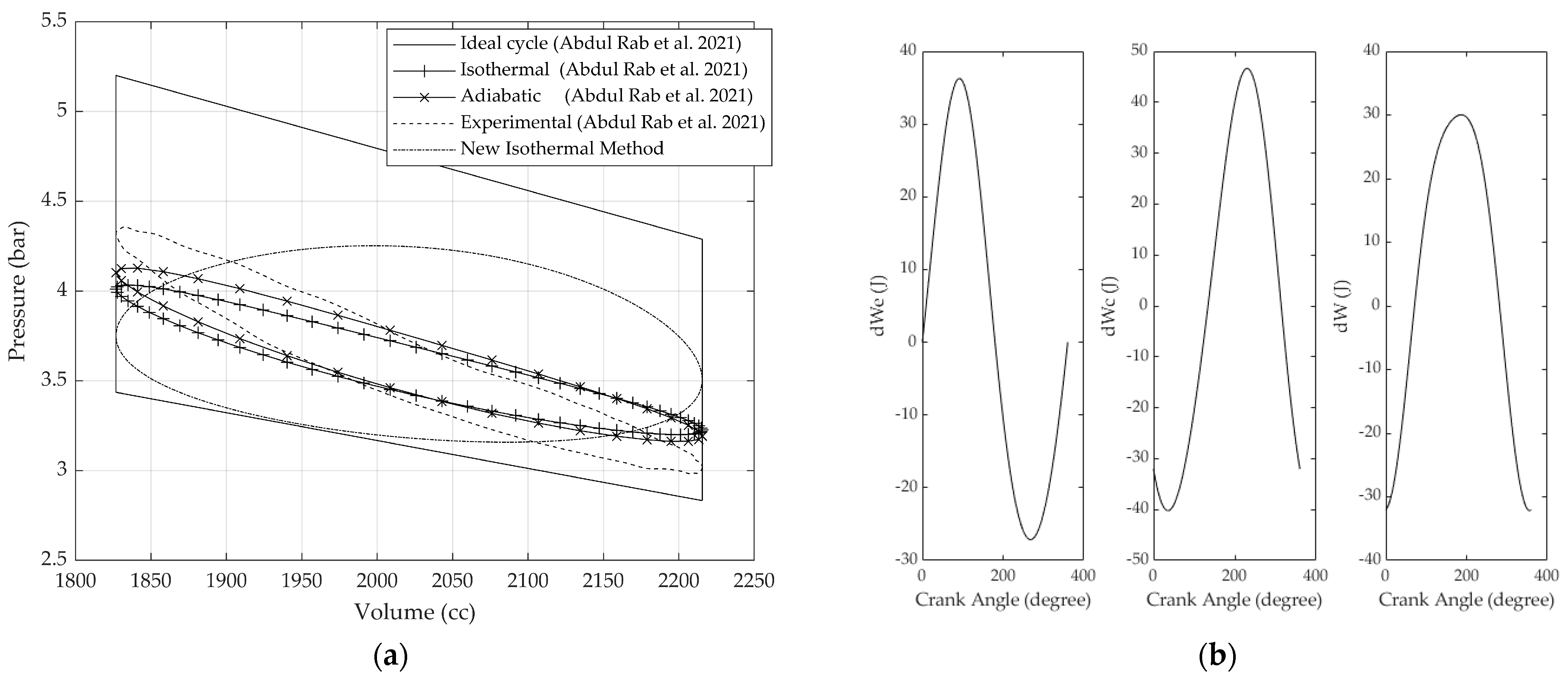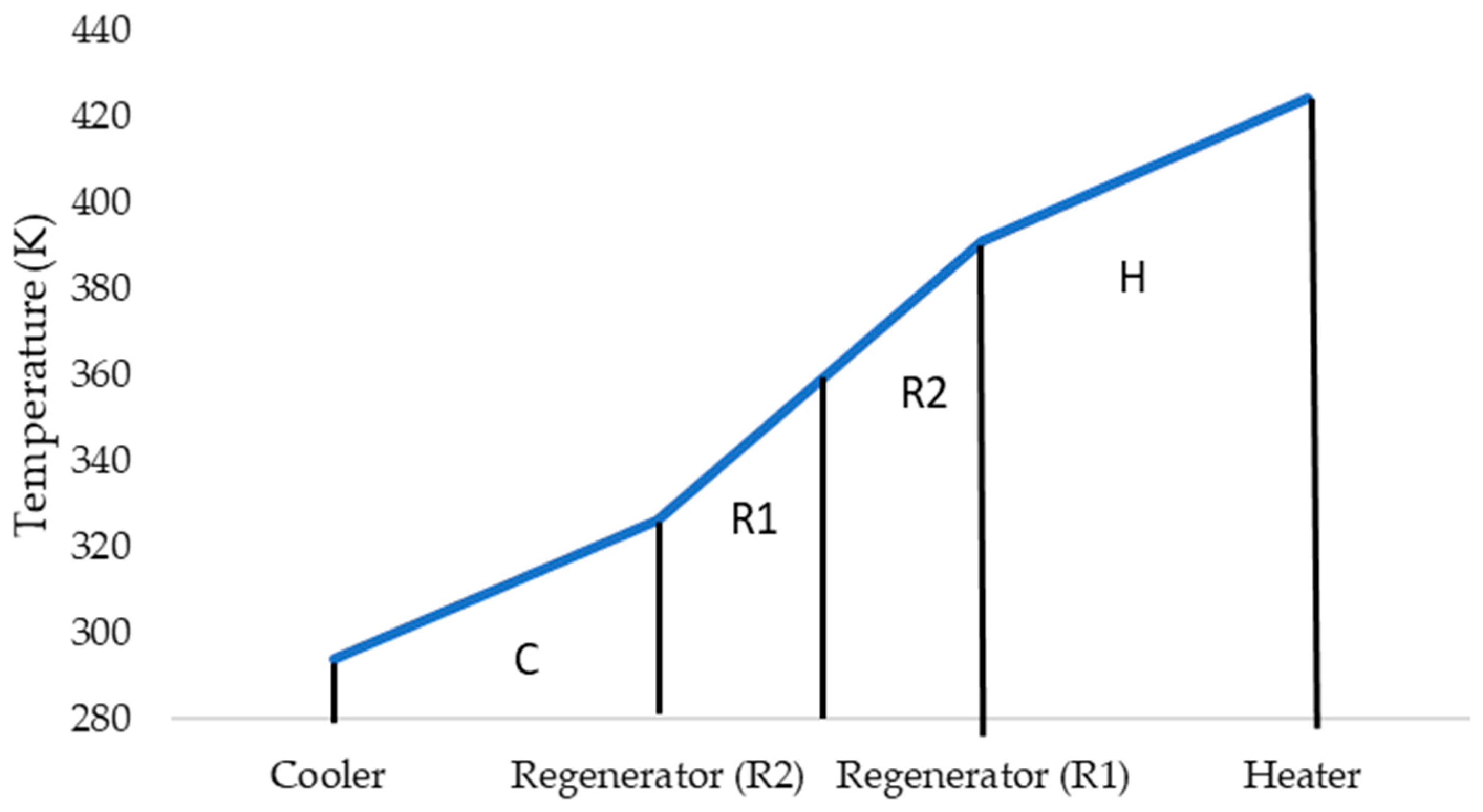A Novel Close Loop Analysis of Gamma Prototype Stirling Engine †
Abstract
:1. Introduction
2. Engine Data
3. Isothermal Method
- The assumption is that the compression and expansion process occurs under isothermal conditions. This means that the working spaces experience no temperature change during these processes, and it is presumed that heat exchangers operate with perfect effectiveness as a consequence of this isothermal assumption.
- The engine maintains a constant speed, and motion is sinusoidal.
- The temperature profile of the regenerator is linear and constant.
- There are no fluid losses and dissipation effects over the cycle.
- The regenerator part is divided into two parts, i.e., the first is connected to the heater (R1) and the second is connected to the cooler part (R2). This is the new assumption made in this isothermal method. For the formulation of the isothermal method above assumptions are considered.
4. Results and Discussion
Model Validation
5. Conclusions
Author Contributions
Funding
Institutional Review Board Statement
Informed Consent Statement
Data Availability Statement
Conflicts of Interest
References
- Abdul Rab, A.; Francesco, C.; Bianca Maria, V. Analysis of Thermodynamic Modelling for Gamma Type Double Piston Cylinder Engine. E3S Web Conf. 2021, 313, 08001. [Google Scholar] [CrossRef]
- Dwijendra, N.K.A.; Sharma, S.; Asary, A.R.; Majdi, A.; Muda, I.; Mutlak, D.A.; Parra, R.M.R.; Hammid, A.T. Economic Performance of a Hybrid Renewable Energy System with Optimal Design of Resources. Environ. Clim. Technol. 2022, 26, 441–453. [Google Scholar] [CrossRef]
- Al Anazi, A.A.; Albaker, A.; Anupong, W.; Asary, A.R.; Umurzoqovich, R.S.; Muda, I.; Romero-Parra, R.M.; Alayi, R.; Kumar, L. Technical, Economic, and Environmental Analysis and Comparison of Different Scenarios for the Grid-Connected PV Power Plant. Sustainability 2022, 14, 16803. [Google Scholar] [CrossRef]
- Ahmadi, M.H.; Ahmadi, M.-A.; Pourfayaz, F. Thermal Models for Analysis of Performance of Stirling Engine: A Review. Renew. Sustain. Energy Rev. 2017, 68, 168–184. [Google Scholar] [CrossRef]
- Zhu, S.; Yu, G.; Liang, K.; Dai, W.; Luo, E. A Review of Stirling-Engine-Based Combined Heat and Power Technology. Appl. Energy 2021, 294, 116965. [Google Scholar] [CrossRef]
- Zare, S.; Tavakolpour-saleh, A.R.; Aghahosseini, A.; Sangdani, M.H.; Mirshekari, R. Design and Optimization of Stirling Engines Using Soft Computing Methods: A Review. Appl. Energy 2021, 283, 116258. [Google Scholar] [CrossRef]
- Martini, W.R. Stirling Engine Design Manual; University Press of the Pacific: Honolulu, HI, USA, 1983. [Google Scholar]
- Wagner, A. Calculations and Experiments on γ-Type Stirling Engines; Cardiff University: Cardiff, UK, 2008; ISBN 1-303-22454-2. [Google Scholar]


| Engine Data | Values | Engine Data | Values |
|---|---|---|---|
| Cooler temperature | 294 | Pressure (bar) | 3.58 |
| Heater temperature | 424 | Rotational speed (rpm) | 882 |
| Cooler void volume | 223 × 10−6 | Phase angle (degree) | 88° |
| Heater void volume | 87.28 × 10−6 | Regenerator void volume (m3) | 308.93 |
| Expansion swept volume (m3) | 221 × 10−6 | Compression swept volume (m3) | 194 × 10−6 |
| Expansion clearance volume (m3) | 24 × 10−6 | Compression clearance volume (m3) | 35 × 10−6 |
Disclaimer/Publisher’s Note: The statements, opinions and data contained in all publications are solely those of the individual author(s) and contributor(s) and not of MDPI and/or the editor(s). MDPI and/or the editor(s) disclaim responsibility for any injury to people or property resulting from any ideas, methods, instructions or products referred to in the content. |
© 2023 by the authors. Licensee MDPI, Basel, Switzerland. This article is an open access article distributed under the terms and conditions of the Creative Commons Attribution (CC BY) license (https://creativecommons.org/licenses/by/4.0/).
Share and Cite
Asary, A.R.; Abdul, B.; Samad, A.; Shibly, M.A.H. A Novel Close Loop Analysis of Gamma Prototype Stirling Engine. Eng. Proc. 2023, 56, 119. https://doi.org/10.3390/ASEC2023-15276
Asary AR, Abdul B, Samad A, Shibly MAH. A Novel Close Loop Analysis of Gamma Prototype Stirling Engine. Engineering Proceedings. 2023; 56(1):119. https://doi.org/10.3390/ASEC2023-15276
Chicago/Turabian StyleAsary, Abdul Rab, Basit Abdul, Abdul Samad, and Mohammad Abul Hasan Shibly. 2023. "A Novel Close Loop Analysis of Gamma Prototype Stirling Engine" Engineering Proceedings 56, no. 1: 119. https://doi.org/10.3390/ASEC2023-15276
APA StyleAsary, A. R., Abdul, B., Samad, A., & Shibly, M. A. H. (2023). A Novel Close Loop Analysis of Gamma Prototype Stirling Engine. Engineering Proceedings, 56(1), 119. https://doi.org/10.3390/ASEC2023-15276







